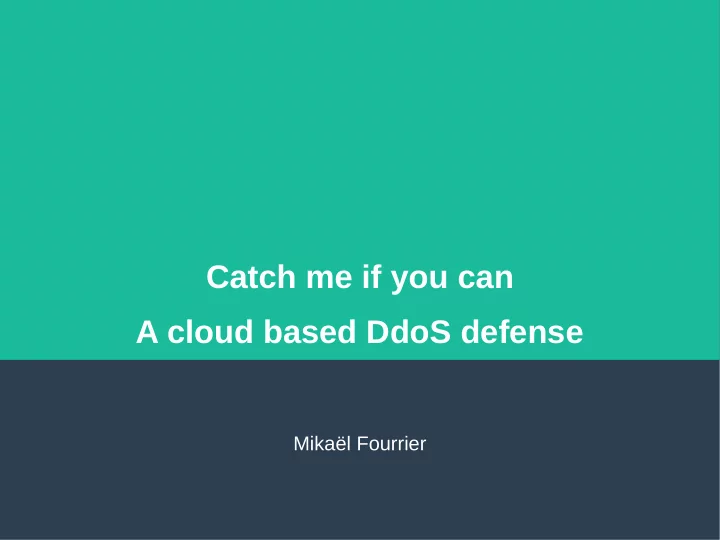

Catch me if you can A cloud based DdoS defense Mikaël Fourrier
DDoS attacks ● Goal: prevent the access to a computer system to it's legitimate users. ● DDoS: DoS attack on the network using a lot of different source IP ● Why: – Reprisal (ex: Anonymous) – Cyber-war or cyber-terrorism – Extorsion ... 2
Examples of DDoS attacks ● Volumetric attack 3
Examples of DDoS attacks ● SYN flood (layer 4) 4
Examples of DDoS attacks ● Application level (layer 7) – Download large file – Make heavy database request – Hit CPU-intensive URL – Upload large file 5
Mitigations ● Have more servers and bandwidth – but useless the rest of the time – costs a lot ● Firewall with an IP blacklist – good for individual attacks, not so good against DDOS and dynamic IPs ● More secure code – only works against specifics attacks like file upload 6
Need a way to dynamically add and remove new servers, only when needed... 7
Enters the “cloud computing” ● Exemple: Amazon EC2 – VM based – Auto-scaling – Quick start of new instances – Pay what you use – Very high total bandwidth and computing power 8
Catch me if you can ● “A cloud-enabled defense mechanism for Internet services against network and computational DDoS attacks” ● Uses a “shuffling” mechanism to segregate attackers and legitimate users ● Add and remove servers to present a moving target 9
Architecture 10
Points of failure ● DNS servers – still a problem ● Load balancers – not a problem with Amazon ● Replica – not a problem with auto-scaling ● Coordination server – not accessible from the internet so not a problem 11
Interlude: Persistent vs naïve bot ● Naïve bot: dumb – can only attack one IP ● Persistent bot: adaptative – can follow a target – understand HTTP redirect 12
Clients segregation ● RS_3 is bot free! ● Some naïve bots can still attack RS_1 and RS_2, so we shut them down ● Use WebSocket to redirect connected clients ● Use of an dynamic programing or greedy algorithm to make the best segregation possible to maximize the number of saved clients 13
Results 14
Discussion ● Dependent on Amazon infrastructure ● Worst case scenario used ● Catch non-aggressive attackers (stateless algorithm) ● Can catch re-entrant bots ● Cost effective and scalable ● Doesn't require an application modification 15
Credits ● Original paper: http://cs.gmu.edu/~astavrou/research/Catch _me_if_you_can_DSN14.pdf ● DdoSBootcamp (images): https://www.ddosbootcamp.com/ 16
Recommend
More recommend